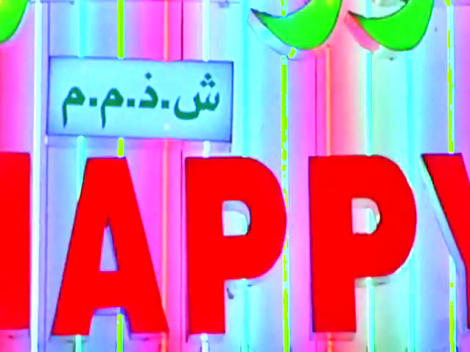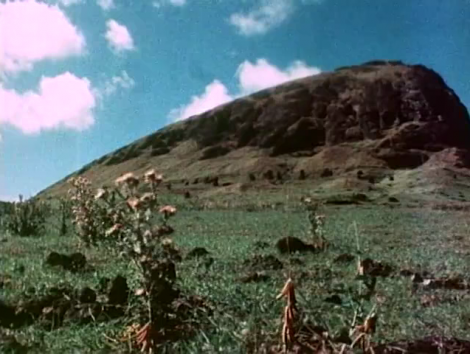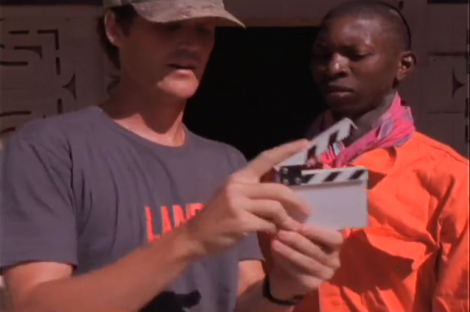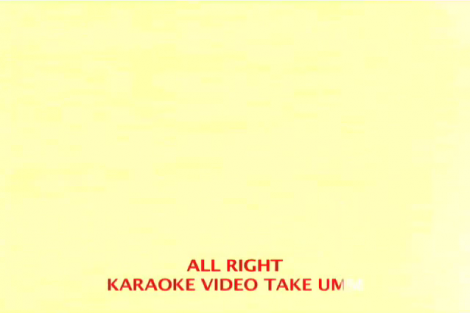7 Question Interview with Ben Russell, Artist & Filmmaker

Ben Russell is a filmmaker, artist, curator, art instructor at the University of Illinois at Chicago, and a great keynote speaker. Perhaps he may be considered a terminologist, for he seemingly has coined the term/genre “psychedelic ethnography,” judging by his writings and recent inspiring lecture at the MCA.
Mr. Russell’s recent three-hour ethnography Let Each One Go Where He May (2009) won a FIPRESCI award at the 2010 International Film Festival Rotterdam. It is a pioneering film in the ethnographic sphere of cinema: an experimental ethnographic film “shot almost entirely with a 16mm Steadicam rig in thirteen extended shots of nearly ten minutes each.”
In the past, Ben developed stimulating relationship with east-coast-Providence-Baltimore-area noise/punk/underground music scene, whence Black Dice was a hardcore band, a period whence he documented the live-event of a Lightning Bolt concert, slow-motion live-action action that is Mr. Russell’s first documentary/ethnographic film, Black and White Trypps Number Three.
In this interview, Ben talks about how he made an underwater remake of the 1991 cinematic classic, Boyz n the Hood.
(1) HEADS AND TAILS (as a metaphor for your filmmaking career): what are your words on: the heads/leader (your start), where you are now, and your tails (however you interpret tails).
HEADS:
I ran away from home when I was six or seven because my parents wouldn’t let me watch Superman on TV; Aliens (1986) was my first R-Rated movie; I had nightmares for weeks from overhearing the sountrack to The Shining (1980). I grew up in the suburbs of Southern California where I got to watch five hours of television a week and would spend my weekends in triple features at the Mission Viejo Mall. I remember watching everything I could, liking all of it. I played Raiders of the Lost Arc (1981) and sometimes Dune in my backyard, made out with a girl named Kim during the credits of Neverending Story 2, made an underwater video remake of Boyz N Tha Hood at summer camp. I don’t remember watching foreign films or documentaries, or at least I didn’t search ‘em out – MTV [i.e. “I want my MTV”] and Max Headroom (1987–1988) and TWIN PEAKS were the bits of media that really blew my mind. “Welcome to the Jungle” totally freaked me out – that image of Axl Rose screaming in an electric chair = proof of image-power.
I went to college to make art and be a marine biologist. I made emotionally fraught photographs of my first girlfriend, lived in Australia for a year and learned about Flaherty, ethnography, Foucault, and conceptual art. I studied with an anthropologist whose research was on Easter Island, I went to Papua New Guinea for 50 minutes, and some time later I returned to Providence, USA, where I made videos under Gregg Bordowitz’s watch and three 16mm films under Leslie Thornton’s quiet stare. Public art, falling asleep during Dead Man (1994), wheatposting, video installation with bark chips, BADLANDS projected in the Fort Thunder parking lot, Wend Kuuni (1992) and cinema-time, Black Dice as a hardcore band. Time passed and I traded Providence for Suriname – two years in the Peace Corps, the only movies I saw in the Paramaribo theater were out-of-focus (Saving Private Ryan, 1998) or burning in the gate (70s GERMAN PORN). Those theaters later became churches, then casinos. I lived in a jungle village, learned an obscure language, wrote a letter a day on a missionary’s typewriter, shot three rolls of super-8 and decided to be a poet.
TAILS:
After grad school, after jungle surrealist films and pinhole films and slow-mo old-timey films and video voice-overs and synch-sound films I moved back to Providence, I got dark and lonesome. Cinema became inert so I tried to find a way out of it, realized that I’d been circling around non-fiction like some dumb buzzard, decided to land and sink my talons into the body that had always clearly been there. Prior to that moment, I’d made images of worlds that were somehow somewhere else – to the left of this one, I used to say. I don’t know if it was heartache or age or that damp Northeastern air, but I suddenly developed a taste for the present that hasn’t left me since. All of those early cinema re-enactments and collaborative ethnographies, the later Trypps and my recent feature [Let Each One Go Where He May (2009)], these are all about addressing the now in a meaningful way. I’m entered into a contract with the present for the sake of the future – however long it may take to roll out.
(2) You teach at UIC. How often do you teach, what courses, how fun, and how (in what ways) challenging?
It’s true – I’ve been there since 2006, been in a classroom since 2003. It seems to be a decent way to find the time and money to make work in parallel, although I’ve of course been really lucky to end up where I am, to have the job that I do. My colleagues are all active, engaged, and prolific artists and I feel privileged to be in their mix. I teach two classes a week, four courses a year – right now it’s 16mm Production: the Portrait and Interdicisiplinary Seminar 1: Contemporary Theory Since 1985, next semester it’ll be Moving Image Topics: The Remake and Psychedelic Ethnography etc etc. UIC has a robust MFA program, so there’s a bit of advising thrown in for good measure, along with challenging critiques and the like. While I never feel like I’m prepared enough and all of that one-sided social interaction can be totally exhausting, it’s still pretty great – at least I enjoy teaching and have a passable stand-up routine for my students. The best part is that I’m still getting smarter by dint of my conversations with the artists that make up our MFA program. I could never really speak cogently about the plastic arts before I started at UIC, but I sure can talk the shit out of ‘em now.
(3) You often use 16mm film. What are your thoughts on film; what are your thoughts on video? What are the provisions for film/video on a project?
Film’s great and video’s great but they’ve both got different economies, histories, and aesthetics. I tend to work in film more than video because I’m getting less and less interested in post-production (I suspect it has a lot to do with not wanting to spend any more of my life in front of a computer screen), and it still seems like that’s where the real possibilities of video lie. I like the restrictions that the cost and materiality of film place on me – I make better decisions when I have structures to butt up against, and the durational concerns that a 100’ or 400’ roll of film presents are really different than what a 60:00 miniDV tape of a solid-state recorder propose. I started using video in 1996 (or so) and have been working with film since 1998, but I still don’t really feel like I understand what video is or how it works. The mechanics of film cameras and projectors, the chemistry of emulsion and developer, the nature of light and reflection – those seem pretty transparent to me, and there’s a real physicality to cinema that I can wrap my head around. This just isn’t the case with video, and I’ve consequently developed more of an affinity to cinema.
As a viewer, I’m totally invested in the cinema experience as well — the projected image, writ large on that silver screen — I don’t watch much television and rarely see movies at home; I find the combination of the social and the spectacular that a theater provides to be one of the most fulfilling experiences I can ask for.
Having said as much, while my first impulse is to choose film over video, as a good conceptual artist there are all sorts of hoops that I force myself to jump through before I settle on one form or the other. Both mediums do radically different things to their subjects, and it is this factor, this notion of what the subject is and how it is going to be presented, that is usually the selling point. By way of example: I was in Mali for a month over the summer making video portraits of Dogon animist “magicians,” and I chose video over film because I wanted these men and women to be as firmly entrenched in the present-that-video-connotes as possible. Video doesn’t age well, whereas film has gone more or less unchanged for the last century – this means that my video image will, at some point in the not-so-far-off, serve as a temporal index for the moment when I captured the semblance of these magicians. Lensed through a 16mm camera, they would’ve been made “cinematic” – removed from time, placed in atmosphere circling somewhere above the present. Of course, I made the opposite decision with Let Each One Go Where He May for that very reason – to mythologize my subjects, however minutely.
(4) You are a Chicago filmmaker. When you hear “Chicago film,” what does that recall?
If I have to be anything at this point in time then I’d prefer to be a “Chicago-based artist” – terms certainly have their uses, but “filmmaker” both limits the conversation and privileges one way of working over all of the other approaches that I employ (video, installation, curation, photography, performance).
As for CHICAGO FILM, it’s getting harder and harder to imagine geography as any kind of a determinant for a style or school of artmaking. The increasingly global nature of media + the relative nomadism of the American population means that borders are pretty tough to pin down. What the phrase CHICAGO FILM does conjure up is a surprisingly rosy image of a super-supportive community of makers, exhibitors, and venues. It’s a great town to make images and sounds in, to be sure, and right now feels like a pretty brilliant moment for such things.

Trypps #7 (Badlands), 10 min, 16mm, color, sound, 2010
(5) Your Trypps series: what was the evolution of this series, project-to-project, 1-7?
I’d just moved back to Providence and was feeling really stuck in this long film about Billy the Kid that I’d shot in Gary, IN, just prior to leaving Chicago. There wasn’t much in the way of experimental film in Providence, so I ended up going to noise shows about four or five times a week, started thinking about how to make what was happening to my body in those spaces take place in the zone of cinema. It seemed too easy to use sound at first, so BWT#1 and BWT#2 were silent. I made both of ‘em pretty quickly as well – initially just to have footage to project for a show in NYC that I was sharing with Joe Grimm and filmmaker Jonathan Schwartz. I screened the footage while Joe was performing, used some of it and shot some more, remember being really excited when I got the rushes back from BWT#2 and felt my body react to the footage by moving towards it… That was the sort of thing I was after, but those first two films felt too modernist, too acritical, and it ultimately made sense to make BWT#3 at a Lightning Bolt show since that was the reason for the series in the first place.
With BWT#3, I felt like it wasn’t enough to just film the concert, that if I did whatever I came up with would just be a lesser version of what the live experience was. I needed to produce something else, to let the film be an experience in of itself – that’s where the slow-motion came into play, the drone that went with it. That film is almost entirely in-camera, and it’s the first instance where I felt like everything happened exactly as I wanted it to, although of course I only set the stage for bits and pieces of it to occur. Significantly, that film marked the first time that I shot footage of the world-in-the-present, something that I’d been avoiding since I first started out.
BWT#4 was initially intended as an apology for the “avant-garde” aesthetics and sensibilities of BWT#1 and BWT#2. I didn’t feel like either of those films were very representative of my interests or abilities as an artist, and I was a bit embarassed that they were both getting play and winning awards around and about. I think they’re fine films, they’re just not what I’m after or about. Anyway – BWT#4 was meant to be a play on words – it’s in four sections, it’s in black and white, it features a black comedian telling jokes about black and white people, and the main character trips (or trypps) during the course of the film. I’d had the footage, 16mm picture slug of Richard Pryor’s 1979 LIVE IN CONCERT, for a few years, and it seemed like the right time to use it – I figured that by making hi-con contact prints of the original footage and then mirroring them in multiple directions, I could make something totally apeshit to watch. I didn’t anticipate the optical effects that would ensue (retinal afterimages! Purplegreenred!) and it wasn’t until I started working with the original sound that I realized how heavy Richard Pryor’s monologue was. The film stopped being an apology and became an attempt to force a critical conversation between race, representation, and experimental cinema.
Black and White Trypps Number Four from Ben Russell on Vimeo.
After all of that hand-processing and contact printing, I was a bit shocked to find TRYPPS #5 (DUBAI) just waiting for me out there in the world. It presented itself to me while I was recording sound on a project in Dubai, and I wasn’t sure for a while afterwards whether or not it was actually a film. Turns out it was – the combination of candy-neon flicker and inquiry into global capital was all it needed. Although that film is technically silent, the beats produced through onscreen movement place it well within the lineage of the other sound films in the series.
I shot TRYPPS #6 (MALOBI) while making LET EACH ONE GO WHERE HE MAY, and while it does exist in a slightly shorter incarnation in the latter film, I do think of it as a film in its own right. I decided to release it into the world with this understanding – my onscren presence with the slate at the beginning of the film not only rhymes with the beginning of BWT#3 (as does the ending, with the flash/photographer), but it foregrounds the essential question of how much is construction and how much is actuality. This doesn’t happen within the context of the feature, or if it does, it transpires in a very different fashion. TRYPPS #6 (MALOBI) makes a great deal of sense within the series, pointing as it does to the function of trance and ritual (á la Jean Rouch), the ethnographic, and the ecstatic. It felt like a great partner to BWT#3 in particular, and I do like that the time of this film is undeniably the same time as the films that preceded it – this is all happening now, in the world.
Like BWT#4, TRYPPS #7 (BADLANDS) was meant to top off the series – we’ll see if that happens or not. This is the first piece that I’ve made specifically for a video installation, and while it’ll soon enough have a life as a single-channel film, I’m presently unsure as to what will be lost/gained when Space and Repetition are taken away, when it becomes a 10:00 film. As it stands, the film is still a bit new for me and I’m unsure as to how/what to talk about it, save that it’s another great instance of serendipity determining the course of events within the frame that I’d established. I initially tried and rather magnificently failed to be the figure onscreen – those cliffside Badlands elements conspired against me, or actually with me, as the end result is much better than any I could’ve imagined…
There’s an ongoing conversation about the function of trance throughout the TRYPPS series, and since the specter of drug use hovers over the secular instances of trance, TRYPPS #7 (BADLANDS) seemed like the right moment to address this topic directly. Ever since seeing FUNERAL PROCESSION OF ROSES, I’ve wanted to make a portrait of someone in an altered state; cinema always seemed like too radical of an imposition however, and it took a really specific failure for me to allow myself to make the seventh film in this series. As was the case with BWT#3, I’m not at all interested in producing a record of experience – the idea of making a record of something so radically subjective and internal (an acid trip) is preposterous. The turns that the film ends up taking are reflective of my attempt to produce a cinema that operates on its own terms, that produces its own experience, that can function as a site of transcendence unto itself.
(6) You are a curator. Tell us more.
After soaking up as much cinema as I could in grad school, my move to Providence intitially felt like some sort of sad desert migration. The kind of critical engagement that I was used to was lacking (although it was happening in other cultural zones – music, in particular), and it seemed that the only way it was going to happen was if I made it materialize. In February of 2004 I started MAGIC LANTERN, a tri-weekly screening series of thematically-curated film and video works, complete with beautiful silkscreened posters and vintage thank-you postcards for all participants. I’d come across a lot of difficult-and-joyless avant-garde film screenings during the years prior, and it was really important for me to find a way to frame works I totally cared about within a context that was neither pandering/populist or exclusive and soul-sucking. Organizing programs according to theme (as opposed to by maker, geography, or time period) made the most sense, and I did this for 20+ shows before trading Providence for Chicago again. I’ve been following a similar approach ever since – I mostly curate film/video programs in relation to gallery exhibits at Gallery400; the shows are related to whatever is up, and I screen the programs in the gallery space in an effort to physically bridge the gap between contemporary art and experimental media.
After a few years of doing programs like this, I had my first solo show and suddenly realized that my curatorial approach was a mirror to my practice – stylistically all-over-the-place but conceptually coherent. I’ve since come to see it as an important piece of my practice on the whole – it serves as a vehicle for sorting out my relationship to the world, to art, to media and vice versa.
Last year I started a gallery space in my apartment called BEN RUSSELL with fellow artist-curator Brandon Alvendia. There wasn’t much money to support the sort of film/video curating I’d been doing in Providence (where I was funded by Brown University and state arts grants) and I felt quite comfortable in what I could do with it, so I decided to move into terrain that I was more uncertain about, a space that truthfully kind of freaked me out. Brandon and I made a set of rules and restrictions about how we would exhibit work, decided to have 5-person group shows with each classically-defined “medium” represented, and determined that we’d use the letters from “ben russell” to determine the themes. We’ve had 8 shows since we started – BEER, BLUENESS, and LESSEN were the best of the lot.

Let Each One Go Where He May, 135 min, 16mm, color, sound, 2009
(7) Seven irrelevant questions:
(A) Do you own a laserdisc player and laserdiscs?
Nope, but when I was in high school I babysat for a family who had CONAN on laserdisc, and I would watch it once the kids were asleep. Would’ve been better to just watch that disc spinning, probably.
(B) What two colors look best together?
Blue + Orange
(C) Name something you hate; name something you love.
Headaches! Always my right eyeball getting stabbed through the back. Optical illusions.
(D) What is your favorite Hollywood action movie?
ALIENS.
(E) What is your favorite alcoholic beverage?
Whisky – on the rocks, as an Old-Fashioned, or styled after the Manhattans my father drinks nightly.
(F) Write seven words on Falco’s “Rock me Amadeus.”
Amadeus Amadeus Oh Oh Oh Oh Amadeus
(G) What have you been listening to lately?
ZZ Pot, Lil Wayne’s NO CEILINGS mixtape, Ministry (only for about 5 songs, though), Lichens, and a Nigerian psych rock compilation from the 70s. Just placed an order for NO MAS by Javelin, an amazing South African Shangaan electro compilation, Major Lazer, and three albums worth of field recordings from Sublime Frequencies. I also just downloaded the new Gucci Mane mixtape, but it’s too bad to be any good.
More:






